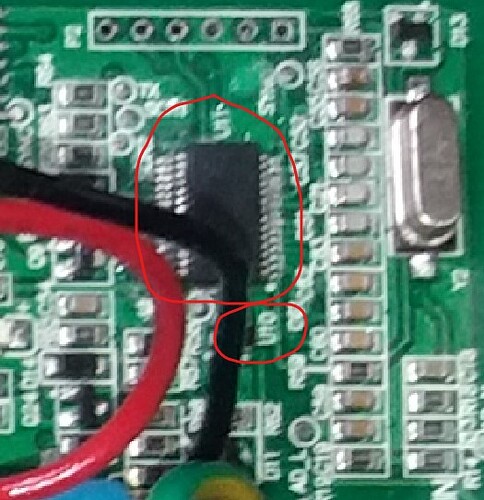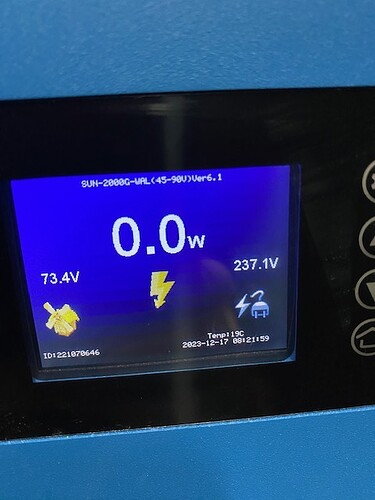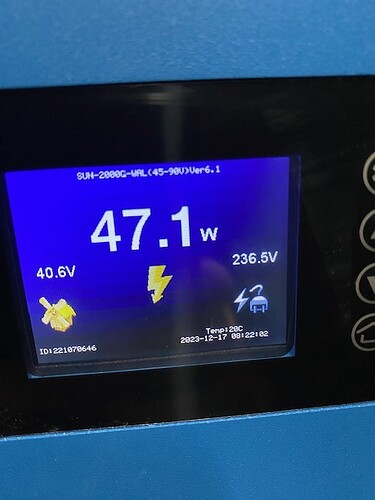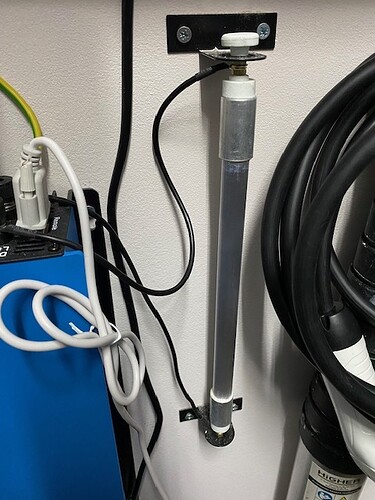I have tried the "Two button reset " but my unit is showing a version number and other settings ( all showing “0” ) execpt input voltage .
After my unit (SUN 1000GTIL2) experienced a major power surge I had the same problem after replacing the burnt components. I found out that the 3.3Vdc supply is shorted and this powers the PIC (U11) responsible for controlling the power inverter section. Unfortunately, the PIC was also shorted along with U10 (see main board). The PIC holds the source code that produces the control signal to operate the power inverter section. I bought a new unit but will keep this old one for the purpose of my research. I’d learned a lot by dissecting it. If only I could find a schematic diagram. =(
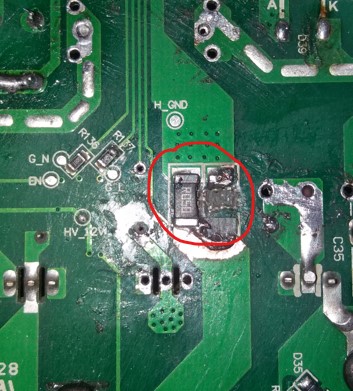
Hi. sr I got same problem. R050 looks like a fuse. My inverter kept 1 r050 its open and the other one probably same valor its bloutout.
That is a resistor. It could be the same problem I experienced. The culprit: driver mosfet IC, IGBT transistor, resistors (050), 12volts IC low voltage side (located underneath (or bottom) the main controller board. After replacing all of these I found out that the PIC controller (shown in the photo) was shorted - pulling +3.3v to GND. The PIC is not something you could replace because this holds the software in managing the ENERGY / POWER production. Replacing the entire board is the only solution.
What is left for me to RE-SALE (in good working condition are: LCD CONTROLLER and MAIN CONTROLLER BOARD).
Hello,
i got a AC-Shortage on my SUN GTIL 2000 after a grid failure.
I had make a Video about that https://youtu.be/RERaG7vXhwY
Question: has anybody a schematic diagram or know the manufacture ?
How many Users of this forum have a broken inverter ?
I got my inverters from aliexpress seller Jesudom Brasil Duty Free Store.
He is not willing to help me. I have buyed my inverter 3 month ago, a really short life and waste money.
Hi everyone. I have found this post and some of the comments sound familiar to the problem I have. I have bought SUN-200G-WAL inwerter with an LCD display and connected it to the wind turbine (96V). The inverter should start producing electricity when the DC voltage reaches 45V. However, it is only able to reach 44-44,5V no matter how strong the wind is. As a result no electricity is produced. I have changed / adjusted the curve settings to zero for 48V, 52V and 60V, but this hasn’t helped. Does anybody have a clue what might be wrong and how I can fix this, so the inverter allows the turbine to pass more voltage and produce electricity.
When I save settings, the inverter allows the turbine to pass more voltage for a couple of seconds and there is some production, but it only lasts a couple of seconds and after that the production goes to zero and voltage moves back to 44-44,5V. I attach some photos of the problem and the current settings:
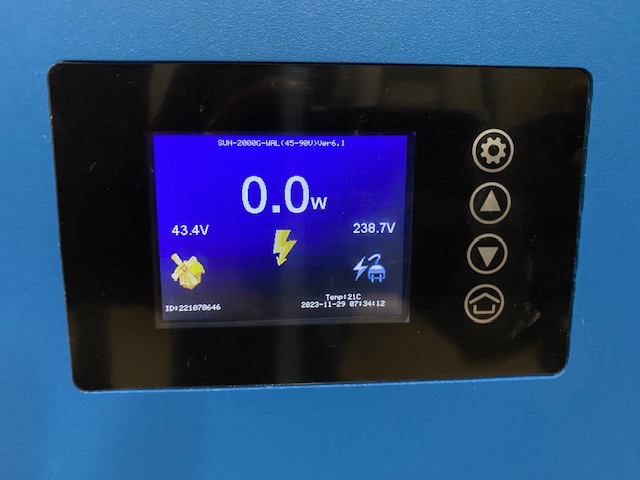
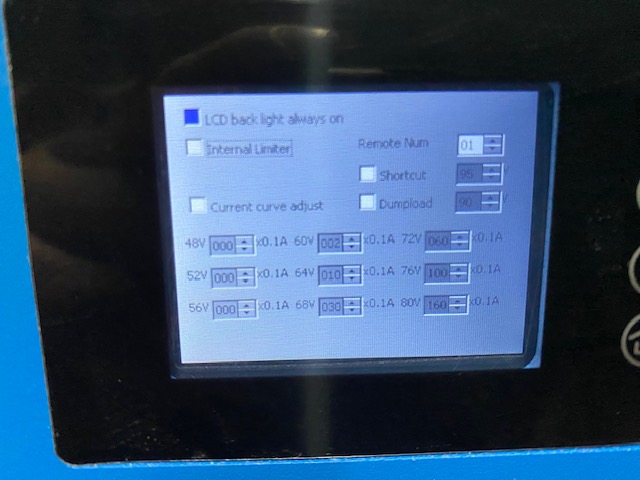
Hi. I have the same problem as You had, but mine is from the very beginning when I connect the inverter to the turbine, Have You managed to solve Your problem and can share the solution?
@radpiot
Please do not post the same content in two places. It only confuses everyone. Thank you.
I have deleted your second topic.
curious your rated voltage of your turbine 96v. I have a 48 volt turbine I and i use a GTI that has a kick in voltage of 22volt. and i have power production range from about 24volt ( 4m/s) to 50 volt ( 12m/s) then the shunt will kick in around 55volt reason I ask is perhaps your turbine is clutching itself due to over speed and that why it not really getting higher then 46 volt is the shunt heating in higher winds . in high wind how would you say your blades are turning relative to your blade speed at low wind speed do you hear it furling . another question is the turbine a 3 phase and is the inverter 3 phase. if not are you passing the 3phase through bridge rectifier first and then to the inverter . if you say your blade speeds are relatively the same speed in low and higher winds i would say either your shunt is activated or your bridge rectifier is shorted.
Hi Stephen,
Thank you for Your answer. I have 3-phase 96V turbine, so no rectifier is needed as the inverter is also 3-phase (WAL version). The turbine is directly connected to the inverter. The connection has been made by a qualified installer who specializes in renewable energy equipment installation. From the description of how You turbine works, I would expect the same for mine but within 45-95V range. For some reason it doesn’t work as expected. The turbine hits the brake when it reaches 44,5V (at inverter’s DC midpoint as written on the inverter specification) no matter how strong the wind is (it’s been between 4 and 9 m/s during the period I have had it connected to the inverter) and the the blades rotate with the same speed at 4 and 9 m/s. After disconneting from the inverter the turbine can easily reach 60-70V (at wind rate of 6-7 m/s) and it is running much faster. Turbine starting wind speed is 2 m/s and rated wind speed is 13 m/s. What is more interesting is the fact that I have thought that if I buy inverter version You have it is going to work, so I’ve bought one with the working volatge between 25 and 65V. The only effect - the turbine has hit the break when the volatge shown on the inverter reached 22V. I have returned this inverter and stick with the 45-95V model.
I’ve thought that maybe the turbine is too weak to pass the 45V, so it the inverter settings I’ve changed the curve settings as shown below, so the trubine should be able to reach 60V, but nothing has changed with the new settings (the turbine hits the brake at 44,5 and it rotates much compared to the situation when I disconnect it from the inverter. I also hear a “booooo” sound when it reaches 44,5V coming from the turbine (after disconnectting the turbine from the inverter the “booooo” sound stops. Tne turbine is VAWT type of turbine, so the blades are not furling (if I understand that term correctly)

What is interesting is the fact that when I save the settings (even if I do not change anything in th settings) the inverter allows the voltage to surpass this 44,5V hurdle for a couple fo seconds and it produces energy. After 4-5 seconds the break is activated again and the voltage falls below 45V and no electricity is generated (please see below - the production starts with a small lag to voltage increase)
You suggest that there might be two reasons for this inverter malfunction - either the shunt is activated or bridge rectifier is shorted. I wonder if this can happen with two inverters as the behavior of the turbine has been similar with two inverters (turbine slows at the inverter starting voltage rates of 22 and 45V respectively, no electricity is produced and the rotation speed is the same no matter what the wind speed is, much slower then after disconneting the turbine from the inverters). I’ve bought the inverters on AliExpress from chinese seller, but they has been delivered to me from a local warehouse 40km from where I live. I have neither got help from the seller nor the inverters producer which I have contacted via email (he has suggested that either the turbine is broken or the inverter is not suitable for the turbine). And the most important question is how I can check if one of these potential reasons (shunt activation or shorting of bridge rectifier) cause the malfunction?
Regards
Radek
Stephen,
Shunt activation probably is not the case (if by shunt You mean that dump load heater - please see photo) as it is cold all the time (the same as when the turbine does not rotate at all because there is no wind)
So could it be broken bridge rectifier?
Couple of things you can try on a light windy day. Disconnect the shunt and see what happens. Do the blades spin up and produce power? You can try removing one phase at a time to see if it spins up, then reconnect it and remove another phase and see if it spins up. (as it can a lot of times, just be one phase that is shorted) Currently to me, seems like something is shorted.
For my inverter bridge rectifier, I use one of these:
mounted to some cooling fins and connected to the DC inputs on the inverter. (after removing the other bridge rectifier) You can test the bridge rectifier with diode function of a multimeter.
If you have a suitable dc power supply, you can test the inverter and see if it works properly that way. To see what’s actually going on or at least if the inverter’s working.
Hi Stephen.
Thanks for useful information. I will do all the testing tomorrow and see what happens. just one question. Does this inverter malfunction might have its cause in the turbine not working properly? The pwer of the turbine might be weak (as with VAWT turbines) but that doesn’t explain that “booo” sound coming from the turbine when the inverter is connected. I have connected 40w light bulb instead today (took the wires from two phases - one from each of two) and the “booo” sound stopped.
The check phase by phase sound very reasonable and that is what I will do (maybe just one phase is shorted). I will test the rectififier with a meter as adviced before taking decision to change it (doesn’t sound very difficult to implement). I do not have the DC input power supply so I have to rely on metering and this phases connection and disconnetion. I will let You know what are the results of the testing are (probably tomorrow).
Regards
Radek
does your turbine have a manual brake installed (alot of time it just a dual pole breaker that wired in a simple pattern when the breaker is open it not braked when closed it braked )… I suspect if you turn on the manual brake it make the same sound. it just the turbine moaning from the dead short
no idea if it has a manual brake installed. is there any easy way to check it? it looks like this:
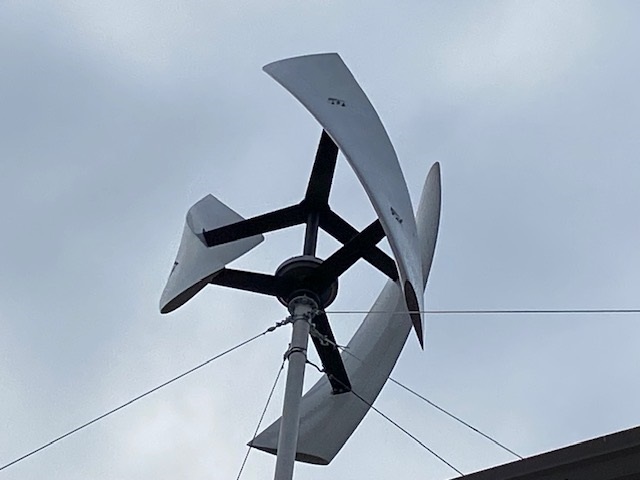
the manual brake should be near your inverter. if not i probably install one. you need one just in case of extreme winds or if your inverter dies so you can safely brake your turbine at any time
Stephen. I think tha I do not have one. Thanks for the advice - I will install one for safety purposes once resolve this turbine - inverter malfunction issue
if one of three phases gets disconnected your genny will make that sound as it becomes a single phase or two phase generator then and is much noisier than a 3 phase. So do check wiring between phases. I think it unlikely that you got two dud inverters in a row and would suspect a short or broken wire in or from your generator, I find when it has occasionally happened in my home built and ageing genny the inverter will be unable to apply a heavy enough load to the genny and the voltage can rise high enough to kick in the dumpload which then slows the genny down and the cycle repeats. It sounds as if you may have a short between two of your three wires which would act as a brake on the genny and keep any voltage low. if you disconect all wires and touch any 2 of the three wires together briefly you should get a spark so take one wire and touch it to one then touch the other or just short between 3 inputs on the inverter. dont do it when the wind is high, just enough breeze to spin the turbine.Maybe get a multimeter.
By emergency brake I assume you mean a way to short all three wires rather than a mechanical brake?
I would suggest activating the lower voltage settings, when you save settings the inverter disconnects which is why they say dont do this with the genny connected/running. I suspect when its disconnected in saving settings it allows the genny to spin up unloaded getting to a high enough voltage to cut in when the inverter reconnects and the voltage then drops because a load is put on the genny slowing it. Maybe try allowing full power at lowest voltage setting and see what happens?

